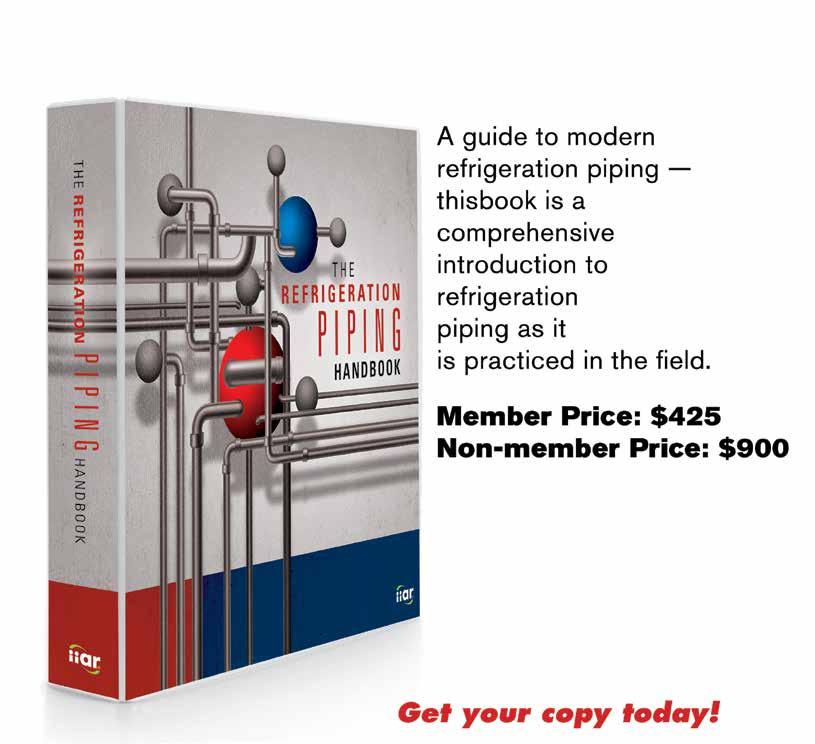
4 minute read
Energy Efficiency
IIAR Energy Efficiency Committee Focuses on Sustainability
espite the cancellation of the International Institute of Ammonia Refrigeration 2020 national conference, IIAR’s newest committee, the Energy Efficiency, and Sustainability Committee, is moving forward with its mission. The panel’s inaugural meeting was to have been at the Orlando conference.
The new committee’s role is to take a broad look at exactly how efficient current ammonia refrigeration facilities are, and what can be done to make them more sustainable in the future.
“I’m really gratified personally,” about the committee’s formation, said Bruce Nelson, who was instrumental in establishing the committee. “This is something I felt strongly about, and others felt strongly about over quite a long period of time — that we should be more active in this area at IIAR.”
During Nelson’s tenure as chair of IIAR, he commissioned a task force, spearheaded by Mike Lynch, Vice President of Engineering at United States Cold Storage, to gauge the interest of IIAR’s membership in these issues. “He came back with a significantly high level of interest [in energy and sustainability issues.]” Nelson said. He noted that Lynch’s company is an end user in the refrigerated warehouse industry with a keen interest in these topics. The initial response generated by the task force was enough for Nelson to move forward with the formation of the committee, he said. As the committee establishes itself, Lynch said it will be important to start with a benchmarking effort to see where the industry stands in terms of efficiency. Ultimately, he said he sees the committee releasing a standard or guidance document for end users on best practices to drive energy efficiency and more sustainable practices in their facilities. Stefan Jensen, managing director of Scantec and chairman of the new committee, agreed that would be the best D
place to start. By documenting power consumption in a multitude of existing facilities across the globe, a pattern would be likely to emerge – a pattern that has not yet been identified, he said.
“A goal of the committee will be to determine what causes the variability [in power consumption,]” Jensen said. “Maybe it’s door openings, maybe it’s the lighting, maybe it’s the orientation of the facility – but the job of the committee will be to analyze which factors have the biggest impact on energy efficiency. When we know that, we’ll be able to advise all interested partners what they should be pursuing and what they should be avoiding.”
While the committee is charged with addressing issues related to energy and sustainability, Nelson said they are two distinct issues that deserve separate consideration. Energy, obviously, is about the consumption of power. This can take a number of forms and has to do with the design of the facilities themselves, he said. Sustainability, on the other hand, has more to do with environmental issues, such as water treatment, water usage, sewerage, and other problems. Nelson said he hopes the committee will address both equally.
One area of focus Nelson is particularly interested in – and one he hopes the committee will address – is the use of heat and the prioritization of its use in cold-storage facilities. He said he has for a long time advocated for the wider adoption of heat pumps to reduce facilities’ carbon footprints.
“The heating load in a food processing plant is most of the time significantly bigger than the refrigeration load. Most of that has to do with water. You’re heating water for cooking or clean up or sanitizing or all of the above,” Nelson said. “Most of the time, you’re just burning natural gas in a boiler to make hot water or steam. With an ammonia heat pump, you can make water that is hot enough to do all of those things.”
E F F I C I E N C Y
More simply put, an ammonia refrigeration system when configured correctly could also be a heating system, significantly reducing not only cost, but also environmental impact. “We should stop thinking about the cooling load exclusively,” Nelson said. “We should start thinking about the heating load as well.” Jensen said that might be one of the biggest hurdles to the committee’s work – the idea that ‘this is how we’ve always done it.’ “There are deeply ingrained design practices that have been around for more than a generation,” he said. “We use certain types of compressors in [Australia] and we control them in a certain way. This is achieving the results that we’re seeing. There’s already some resistance to change. These are problems we’ll have to overcome.”
Speaking to the importance of such a committee, Lynch says the time is right to start considering energy and sustainability topics in earnest. “When you look at the industry, and you look at the type of equipment that our industry uses, we’re very heavy users of electricity,” Lynch said. “Anything we can do to help [end users] reduce their energy use would: a) help reduce their cost; and b) help reduce their carbon footprint, ultimately having a positive impact on the environment.”
Jensen agreed, and added that if the ammonia refrigeration industry is to position itself as more environmentally friendly than its competitors, these are discussions that need to take place. “Just because we use ammonia as a natural refrigerant, that’s no guarantee that the plant is energy efficient,” he says. “If we’re really about sustainability, we cannot fail to discuss energy efficiency. That is what this is about.”










